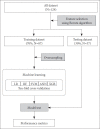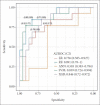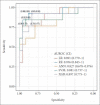Classification of Adolescent Psychiatric Patients at High Risk of Suicide Using the Personality Assessment Inventory by Machine Learning
- PMID: 34732031
- PMCID: PMC8600215
- DOI: 10.30773/pi.2021.0191
Classification of Adolescent Psychiatric Patients at High Risk of Suicide Using the Personality Assessment Inventory by Machine Learning
Abstract
Objective: There are growing interests on suicide risk screening in clinical settings and classifying high-risk groups of suicide with suicidal ideation is crucial for a more effective suicide preventive intervention. Previous statistical techniques were limited because they tried to predict suicide risk using a simple algorithm. Machine learning differs from the traditional statistical techniques in that it generates the most optimal algorithm from various predictors.
Methods: We aim to analyze the Personality Assessment Inventory (PAI) profiles of child and adolescent patients who received outpatient psychiatric care using machine learning techniques, such as logistic regression (LR), random forest (RF), artificial neural network (ANN), support vector machine (SVM), and extreme gradient boosting (XGB), to develop and validate a classification model for individuals with high suicide risk.
Results: We developed prediction models using seven relevant features calculated by Boruta algorithm and subsequently tested all models using the testing dataset. The area under the ROC curve of these models were above 0.9 and the RF model exhibited the best performance.
Conclusion: Suicide must be assessed based on multiple aspects, and although Personality Assessment Inventory for Adolescent assess an array of domains, further research is needed for predicting high suicide risk groups.
Keywords: Child and adolescent psychiatry; Machine learning; Personality Assessment Inventory-Adolescent; Suicide.
Conflict of interest statement
The authors have no potential conflicts of interest to disclose.
Figures




References
-
- Ladame F, Jeanneret O. Suicide in adolescence: some comments on epidemiology and prevention. J Adolesc. 1982;5:355–366. - PubMed
-
- O’Carroll PW, Berman AL, Maris RW, Moscicki EK, Tanney BL, Silverman MM. Beyond the Tower of Babel: a nomenclature for suicidology. Suicide Life Threat Behav. 1996;26:237–252. - PubMed
-
- OECD Suicide rate. 2017. Available at: https://data.oecd.org/healthstat/suicide-rates.htm. Accessed May 27, 2021.
-
- Statistics Korea Causes of death statistics in 2019. Available at: http://kostat.go.kr/assist/synap/preview/skin/doc.html?fn=synapview38521.... Accessed May 27, 2021.
Grants and funding
LinkOut - more resources
Full Text Sources

